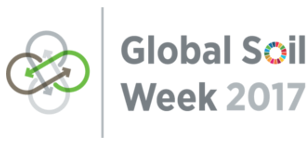To launch the 2nd Global Soil Week (27-31 October 2013), IASS Executive Director Professor Klaus Töpfer, Volkert Engelsman from the “Save Our Soils” campaign and environmental activist Vandana Shiva broke up sealed soil at Potsdamer Platz and planted it with vegetables. Through their symbolic action they drew attention to the serious consequences caused by the increased impervious coverage of the soil: soils are vanishing that are vitally important for producing food, absorbing and filtering water, storing carbon and – particularly in cities – filtering pollutants from the air.
“Given current growth rates, global urban areas will double throughout the world during the next 20 years, which is equivalent to sealing ground the size of South Africa. This is why a key to sustainable soil use can be found in the urban sphere. We must limit the progressive sealing and find ways to make soil fertile again so that we can create uninterrupted resource cycles,” said IASS Executive Director Professor Klaus Töpfer.
In the EU 200 m2 of ground is already sealed per inhabitant. In Germany alone, a total of 27 hectares of sealed ground is added daily, which in particular is caused by the expansion of the transport network. In order to restore just 2.5 cm of degraded soil requires up to 500 years.
During the joint symbolic de-sealing action, Volker Engelsman, initiator of the “Save Our Soils” campaign, declared: “There is very much a need to inform and educate people about the soil issue. The “Save Our Soils” campaign, which was initiated by Soil & More together with the FAO and many other partners, provides an important contribution here and also shows where solutions can be found.” Vandana Shiva, environmental activist and a patron of the campaign, warned: “The destruction of soil concerns all of us, but the countries in the south are already worst affected by the consequences. That’s why we must unite together in the worldwide struggle to prevent soil degradation. Millions of organic farmers are already making a considerable contribution to saving soils.”
Based on the success of 2012, the IASS is hosting the 2nd Global Soil Week under the motto “Losing Ground?” along with representatives from politics, research, the private sector and civil society. The event is being held in Berlin from 27 to 31 October. With its Global Soil Week, the IASS offers a platform for anchoring the protection of soils in the Global sustainability Goals (SDGs). National and international partners include the European Commission, the United Nations Food and Agriculture Organisation (FAO), the United Nations Environment Programme (UNEP), the United Nations Convention to Combat Desertification (UNCCD), the German Federal Ministry for Economic Cooperation and Development (BMZ), the Deutsche Gesellschaft für Internationale Zusammenarbeit (GIZ) and the German Federal Environment Agency (UBA). More than 400 participants from 70 countries participate this year.
For more information, please contact
Corina Weber
Head of Press & Communication
+49 331 288 22-340 / Corina.Weber@iass-potsdam.de
The background: Sealed soil = Lost soil
Soil sealing is primarily concentrated in cities: In 2006, around 47% of urban land in Germany was sealed, this corresponds to 5% of the total land area of Germany.
With every square metre of sealed soil we are losing ground – our basis for:
• food production
• ability to absorb water
• absorption of carbon
• filtering of air pollutants
If land and, thus, the underlying soil is permanently covered by an impermeable artificial material such as, for example, asphalt or concrete, it is sealed. Non-visible constructions beneath the land surface are also a type of soil sealing. This includes cables, canals, foundations and heavily compacted soil. In order to seal land, the uppermost soil layer, which provides most of the ecosystem services, is generally removed. The soil beneath is then compacted inhibiting its ability to store water. Since the soil removed is often not used at another site, soil sealing literally results in soil loss.


